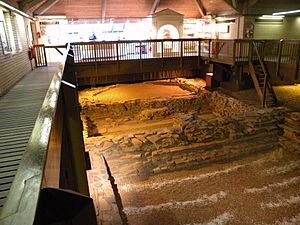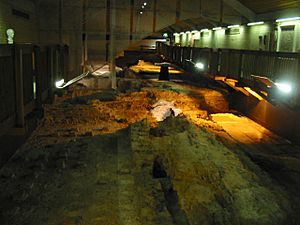Caerleon Roman Fortress and Baths facts for kids
 |
|
| Lua error in Module:Location_map at line 420: attempt to index field 'wikibase' (a nil value). | |
| Location | Caerleon, Newport, Wales |
|---|---|
| Type | Archaeological museum |
| Owner | Cadw |
Caerleon Roman Fortress and Baths are amazing ancient Roman ruins in the town of Caerleon, near Newport in South Wales. This site was once a huge Roman army base called Isca Augusta. It's special because it's one of only three main Roman army forts in all of Roman Britain. The other two were in York and Chester.
What makes Caerleon so unique is that its Roman remains are very well preserved. Later towns didn't build over them as much. This has given archaeologists a great chance to study how Roman soldiers lived. Today, you can visit several parts of the old fortress. These include the 'Caerleon Roman Fortress and Baths' museum, which shows off the old bath-house. You can also see Britain's most complete Roman amphitheatre, parts of the soldiers' barracks, and the National Roman Legion Museum.
Contents
History of the Roman Fortress
Why Caerleon was Important
Roman Wales was the furthest west the Roman Empire reached in Roman Britain. To protect this border, the Romans built a strong fortress at Caerleon in AD 75. This fortress was one of only three permanent army bases in Roman Britain. It was used by Roman soldiers for over 200 years.
Discovering Roman Caerleon
Early Explorations
People have known about Caerleon's Roman ruins for a very long time. The earliest description was written by Gerald of Wales in the 1100s. He wrote about grand palaces, huge baths, temples, and theatres. Even though some of his descriptions might have been exaggerated, they showed that Caerleon was an important historical place.
In the 1840s, people started digging more formally. This led to the creation of the Caerleon Antiquarian Association in 1847. Their goal was to dig up more Roman remains and create a museum to keep the finds. An early project was digging up an old bathhouse outside the fortress walls.
Building the Museum
The new discoveries made people want a museum even more. In the summer of 1850, the Caerleon museum opened to the public. It displayed newly found items and many things donated by local people. This museum later grew into the National Roman Legion Museum.
In the 1900s, more groups started digging at Caerleon. One group, the 'Liverpool Committee', explored a corner of the fortress walls. They also did early digs at the Amphitheatre in 1908. These digs showed some well-preserved walls.
Major Discoveries in the 1920s
After World War I, the 'Caerleon Excavation Committee' was formed. It was led by Mortimer Wheeler, who was the director of the National Museum of Wales.
- The Amphitheatre (1926-1927): This committee bought the amphitheatre site. Over 14 months, they removed a huge amount of soil. They uncovered the entire original floor, entrances, and seating areas. Once finished, the site was given to the government to be preserved.
- Prysg Field (1927-1929): More digs in Prysg Field uncovered the western ramparts (defensive walls) and many barracks blocks. The foundations of these barracks were then made into a public park.
These digs in the 1920s helped confirm where the fortress walls were. They also showed that the fortress was first built with a ditch and clay rampart in 75 AD. Stone walls were added 25 years later. The wooden barracks were replaced with stone ones around 115 AD.
In 1930, the Caerleon Antiquarian Association gave their museum to the National Museum of Wales. In 1987, the old museum building was mostly taken down. A new, much bigger National Roman Legion Museum was built in its place.
Recent Archaeological Work
In the 1970s, new archaeological work began. From 1977 to 1981, archaeologists dug up the fortress baths. It's thought that the baths were the only stone building when the fortress was first built in 75 AD. Many parts of the baths were kept in place and opened to the public in 1980. They are now looked after by Cadw.
From 1984 to 1990, the focus moved outside the fortress walls. Archaeologists explored the canabae, which was the civilian town that grew up around the army base. These digs showed that the civilian settlement was much larger and more varied than people first thought. It was part of a Romanized area with other towns nearby.
In 2007, new research and training digs began at Priory Field. These digs found a large square building that was likely used for storage by the Roman army. This building was built early in the fortress's history and was taken down around 350 AD. Thousands of items were found, including complete sets of Roman armour! An inscription found showed that the building was built by Flavius Rufus, a high-ranking Roman soldier.
In 2011, another important dig happened between the Amphitheatre and the River Usk. This dig confirmed the location of a Roman port along the river. This is only the second Roman port known in Britain, after London! They also found three huge public buildings with large courtyards. These buildings might have been used for managing the army or the area, and the courtyards could have been assembly areas for soldiers and animals arriving at the port.
Roman Baths Museum
The Roman Baths Museum is located inside the fortress walls, very close to the National Roman Legion Museum. These were the main baths for the Roman soldiers. The museum has a covered walkway that lets you see parts of the ancient bathhouse.
The baths had different sections:
- A frigidarium (cold room)
- A tepidarium (warm room)
- A caldarium (hot room)
- An open-air swimming pool
The baths museum is managed by Cadw. It uses special projections to show what it might have looked like when Roman soldiers were bathing there.
Within a short walk of the baths museum, you can also visit:
- Britain's most complete Roman amphitheatre.
- Sections of the original fortress walls.
- The only remains of a Roman legionary barracks that you can see in all of Europe at Prysg Field.
Over 40,000 people visited the Baths in 2012.
See also
- Caerleon pipe burial
- National Roman Legion Museum
- Newport Museum
- Venta Silurum
- List of scheduled monuments in Newport



